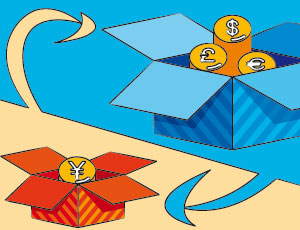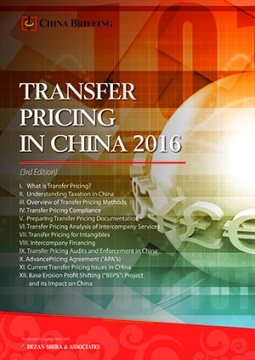China’s Transfer Pricing Obligations
 Nov. 21 – Transfer pricing concerns the prices charged between associated enterprises established in different tax jurisdictions for their inter-company transactions. Relevant prices are those for services, intangible property and financing activities.
Nov. 21 – Transfer pricing concerns the prices charged between associated enterprises established in different tax jurisdictions for their inter-company transactions. Relevant prices are those for services, intangible property and financing activities.
The transfer pricing regime in China is generally consistent with the OECD guidelines and has developed rapidly over the past few years. A number of factors brought transfer pricing issues to the forefront of the State Administration of Taxation’s attention, including the tendency for FIEs in China to declare operating losses and to rely on intellectual property and services provided by overseas related parties, as well as the introduction of tough transfer pricing regimes by key trading partners. The 2008 tax changes increased the incentive to use transfer pricing to influence effective tax rates, and in 2009, the SAT released the Transfer Pricing Regulations.
China requires taxpayers to prepare and retain detailed transfer pricing documentation to support the arm’s length nature of their related party transactions. All transactions between a HQ and a Chinese subsidiary should be conducted based on the arm’s length principle, as a HQ and Chinese subsidiary are related parties according to Chinese tax laws.
Transfer pricing can create considerable managerial challenges, as it has a direct effect on the profits of both parties. Designing a transfer pricing system early in the business cycle helps to mitigate and manage transfer pricing risk exposure and ensure that the system is the most tax effective, consistent with business model and commercial objectives and documented efficiently.
Basic Transfer Pricing Obligations
When filing annual tax returns, enterprises for which the annual amount of related party tangible goods transactions is below RMB200 million and the amount of related party intangible goods transactions is below RMB40 million should submit the nine “Enterprise Annual Reporting Forms for Related Party Transactions of the People’s Republic of China.”
These forms (in Chinese) include a large amount of detail of the amounts and types of related party transactions, the level of documentation available and methodology used to test the arm’s length nature of the transactions, and the level of profitability on these transactions.
Enterprises exceeding this transaction threshold may also need to maintain contemporaneous transfer pricing documentation.
Contemporaneous Documentation Requirements
Contemporaneous documentation is detailed transfer pricing documentation to support the arm’s length nature of related party transactions.
Contemporaneous documentation needs to be prepared by parties that do not meet one of the following exemption requirements:
- Annual amount of related party tangible goods transactions is below RMB200 million and the amount of related party intangible goods transactions is below RMB40 million
- The transactions are covered by an advanced pricing arrangement (APA)
- The foreign shareholding is below 50 percent and the enterprise only transacts with domestic related parties
Definition: Related Parties
“Related party” is defined in the China Transfer Pricing Regulations as any of the following:
Ownership or Control
One entity directly or indirectly holds a total of 25 percent or more of another entity’s shares; a third party owns or controls, directly or indirectly, 25 percent or more of the shareholdings in both enterprises – the calculation of indirect holding should be made through multiplying with share proportion of each layer; however, if one entity holds over 50 percent of the shares of the other entity of next layer, it would be deemed to hold 100 percent at this layer
Debts
Debts owed by one enterprise to another enterprise (except a third party financial institution) exceed 50 percent of the enterprise’s capital, or 10 percent of the total debt owed by one enterprise is guaranteed by another enterprise (except a third party financial institution)
Senior/Executive Management Appointment
More than half of one enterprise’s senior management personnel (including the board of directors and the general manager), or at least one of the executive members of the board of directors are appointed by another enterprise, or two enterprises with more than half of their senior management personnel or more than one executive director is appointed by a same party
Licensing of Intangibles
One enterprise’s normal production and operation activities are dependent on intangibles licensed from another enterprise (including industrial property rights or patented technology)
Raw materials/Spare Parts Control or Supply
The purchase of raw materials or spare parts by one enterprise is under the control of or must be supplied by another enterprise (such control includes control over prices and terms of transactions)
Service Provision or Receipt Determination
One entity’s provision or receipts of services is determined by another enterprise
Actual Control
One enterprise has actual control over the other enterprise’s production, operation, and trading activities through relationships associated with other interests (including family relationships)
A Quick Look: Advance Pricing Arrangements
What is an advance pricing arrangement (APA)?
An APA is a multi-year agreement reached with the tax authority on an enterprise’s related transactions pricing principles and calculation method.
What conditions must an enterprise satisfy in order to apply for an APA in China?
APAs are generally applicable to enterprises satisfying all of the below criteria:
- Having an annual related transaction volume exceeding RMB40 million;
- Having performed the obligation of filing statements on its related transactions and related parties in accordance with the law;
- Having prepared, preserved and submitted contemporaneous materials according to the relevant provisions.
What are the benefits of having an APA?
There are a few advantages to having an APA:
- It provides certainty in terms of both the operation and tax payable in the next few years;
- It resolves the transfer pricing issue;
- It lowers the risk of being investigated; and
- It avoids double taxation.
How does an enterprise apply for an APA?
The time for completion of a unilateral or bilateral APA generally takes anywhere from a year to two and a half years, and in rare cases three or more years for bilateral APAs.
There are generally six stages involved in the negotiation, execution and implementation of APAs, namely:
- Preparation meetings;
- Formal application;
- Examination and appraisal;
- Negotiation;
- Signing of arrangements; and
- Supervision and implementation.
What kinds of APAs are available in China?
Unilateral, bilateral or multilateral APAs are available in China. No multilateral APAs have been successfully concluded yet.
 Portions of this article came from the November 2012 issue of China Briefing Magazine titled, “International Related Party Transactions.” In this issue, we turn once again to the issue of international transactions, specifically those between related parties. Topics include service agreements for HQ and subsidiaries, an overview of transfer pricing obligations in the country, and China’s cross-border RMB pilot settlement project.
Portions of this article came from the November 2012 issue of China Briefing Magazine titled, “International Related Party Transactions.” In this issue, we turn once again to the issue of international transactions, specifically those between related parties. Topics include service agreements for HQ and subsidiaries, an overview of transfer pricing obligations in the country, and China’s cross-border RMB pilot settlement project.
Dezan Shira & Associates is a specialist foreign direct investment practice, providing corporate establishment, business advisory, tax advisory and compliance, accounting, payroll, due diligence and financial review services to multinationals investing in emerging Asia. Since its establishment in 1992, the firm has grown into one of Asia’s most versatile full-service consultancies with operational offices across China, Hong Kong, India, Singapore and Vietnam as well as liaison offices in Italy and the United States.
For further details or to contact the firm, please email china@dezshira.com, visit www.dezshira.com, or download the company brochure.
You can stay up to date with the latest business and investment trends across China by subscribing to The China Advantage, our complimentary update service featuring news, commentary, guides, and multimedia resources.
![]()
 Transfer Pricing in China 2016
Transfer Pricing in China 2016
Transfer Pricing in China 2016, written by Sowmya Varadharajan in collaboration with Dezan Shira & Associates and Asia Briefing, explains how transfer pricing functions in China. It examines the various transfer pricing methods that are available to foreign companies operating in the country, highlights key compliance issues, and details transfer pricing problems that arise from intercompany services, intercompany royalties and intercompany financing.
 Annual Audit and Compliance in China 2016
Annual Audit and Compliance in China 2016
In this issue of China Briefing, we provide a comprehensive analysis of the various annual compliance procedures that foreign invested enterprises in China will have to follow, including wholly-foreign owned enterprises, joint ventures, foreign-invested commercial enterprises, and representative offices. We include a step-by-step guide to these procedures, list out the annual compliance timeline, detail the latest changes to China’s standards, and finally explain why China’s audit should be started as early as possible.
Managing Your Accounting and Bookkeeping in China
In this issue of China Briefing, we discuss the difference between the International Financial Reporting Standards, and the accounting standards mandated by China’s Ministry of Finance. We also pay special attention to the role of foreign currency in accounting, both in remitting funds, and conversion. In an interview with Jenny Liao, Dezan Shira & Associates’ Senior Manager of Corporate Accounting Services in Shanghai, we outline some of the pros and cons of outsourcing one’s accounting function.
- Previous Article China Profit Repatriation Techniques
- Next Article China’s Long-term Plan to Import Thousands of Highly-Qualified Foreigners










